|
|
 |
Chinese Noodles
|
6 October 2006
...and a few mangoes in the basket for balance. 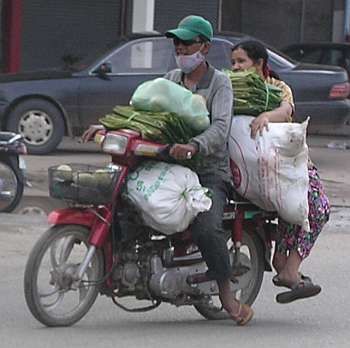
Motorcycle Passengers and Cargo #37
28 September 2006
The Deaf Day celebration in Kampong Chhnang was held in a somewhat remote primary school in a poor part of the province. The school doesn't have electricity (only 17% of Cambodia has electricity) so this mobile generator was brought in to provide power for the musicians' instruments and for the microphone system. 
27 September 2006
Today at the deaf program, one of the boys brought me these two photographs. He lives in this house on the outskirts of Phnom Penh, and he was bursting with pride because they had saved up enough money to buy a new wall for his house.
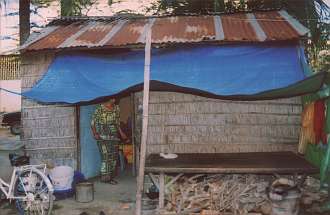 The walls of the house are made of palm tree leaves, woven into a wooden frame which is then hung from the corner posts of the house. The boy told me he sleeps on the wooden platform in front of the house. Firewood is stored under the bed which also serves as the living room and table for the family. All family activities take place on top of the bed/table. The bicycle on the left was bought for him by the Deaf Development Program so he could come to school.
The walls of the house are made of palm tree leaves, woven into a wooden frame which is then hung from the corner posts of the house. The boy told me he sleeps on the wooden platform in front of the house. Firewood is stored under the bed which also serves as the living room and table for the family. All family activities take place on top of the bed/table. The bicycle on the left was bought for him by the Deaf Development Program so he could come to school.
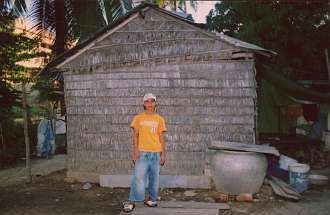 This the new wall of the house with our student standing in front of it. The wall cost 4800 riel, about $1.18. It would take this family quite a while to save up that much money. The family probably earns only 15,000 or 20,000 riel a day, and most of that would have to go for food, school fees for his brothers and sisters (DDP is free), transportation to work, etc. The big cement vat is called a beam and is used to store rain water for cooking, cleaning, and maybe for drinking also unless there happens to be a well nearby.
This the new wall of the house with our student standing in front of it. The wall cost 4800 riel, about $1.18. It would take this family quite a while to save up that much money. The family probably earns only 15,000 or 20,000 riel a day, and most of that would have to go for food, school fees for his brothers and sisters (DDP is free), transportation to work, etc. The big cement vat is called a beam and is used to store rain water for cooking, cleaning, and maybe for drinking also unless there happens to be a well nearby.
26 September 2006
This husband and wife team are delivering live fish. The fish ride in the large metal box on the back of the motorcycle. The wife rides on top of the box. It's a fairly common sight in Phnom Penh. 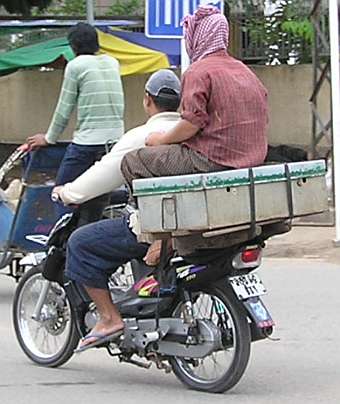
Motorcycle Passengers and Cargo #36
23 September 2006

Pchum Ben Festival
15 September 2006
A load of sugarcane. Vendors on the street run it through rollers on their cart, much like the wringers of old washing machines. The juice is squeezed out and mixed with water for a refreshing, natural drink. 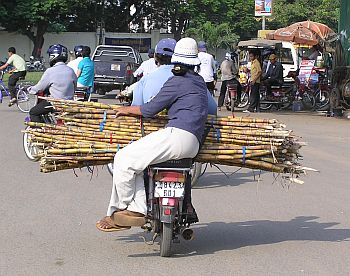
Motorcycle Passengers and Cargo #35
13 September 2006
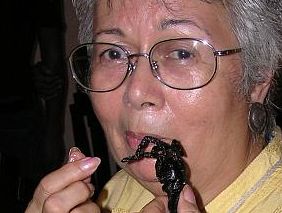
Her expression seems a bit pained but Roberta McLaughlin swears that the tarantula she is eating was delicious! The fried spiders are a popular snack in Cambodia, but their future is threatened by the encroachment of people on their natural habit. They're not scarce yet, but spider traders say that the destruction of their jungle habitat, to plant crops like cashews, is making the hairy delicacies harder and harder to find.
12 September 2006
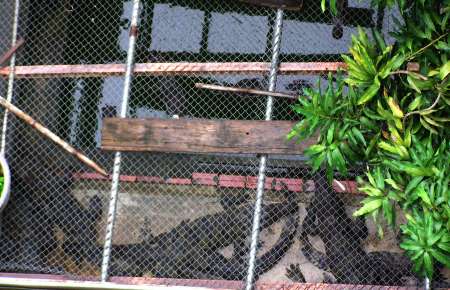
One of the attractions of our new office building for the deaf program was the unexpected discovery of a pit full of fifteen crocodiles just behind our back wall. From our upper floors, we could look straight down at the crocs below. I was looking forward to seeing what the crocs ate, how often, and how much, but was disappointed to see absolutely no activity on the part of humans connected with the animals. The 5 to 7-foot reptiles just lay there day after day, sometimes stacked up two or three deep along the narrow ledge, sometimes floating idly in the two-foot deep concrete pond that was part of their enclosure.
But then yesterday, the crocodiles--a native species found in the wild in Cambodia--were taken away. Four men came with a noose on a pole, lassoed each one, wrapped it in burlap and tied it tightly, and then carted them off. Probably today they are their way to becoming crocodile stew or leather shoes. We're just hoping that new crocs will replace the old ones.
8 September 2006
"Since we're already out and we've still got time, let's go pick up that mattress, too...." 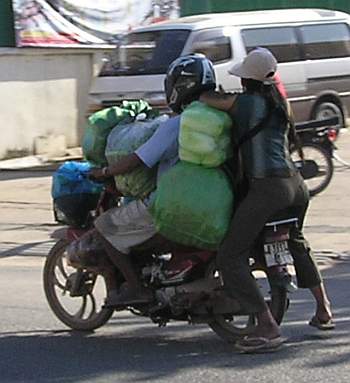
Motorcycle Passengers and Cargo #34
7 September 2006
The corn harvest is in, and everywhere on the streets these days are vendors' carts loaded with freshly boiled or freshly roasted corn for 1000 riel (25¢) an ear. Here is one happy vendor on the streets of Phnom Penh. [Photo by Maryknoll Lay Missioner Jim McLaughlin] 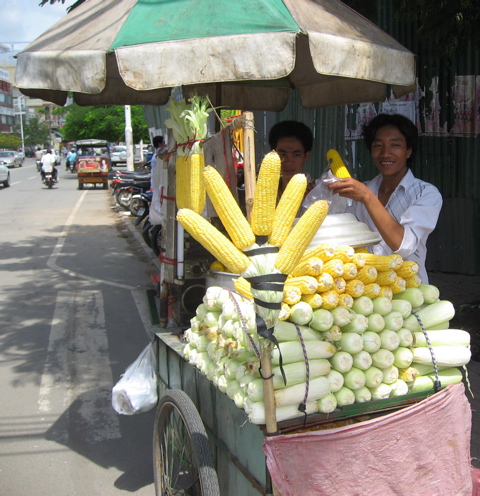
2 September 2006
Delivering a load of cushions or bolsters. At least they're light and soft. 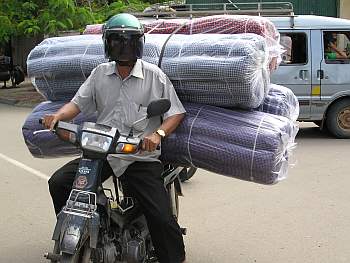
Motorcycle Passengers and Cargo #33
1 September 2006
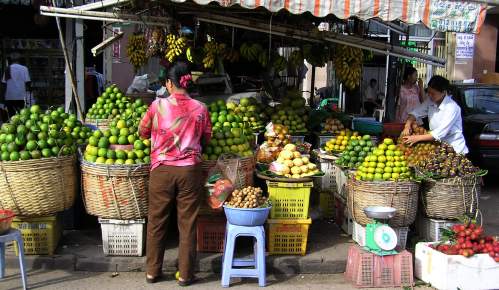
Nehru Street (or Nerhu Street, as it is spelled on the street signs) is near the Olympic Stadium and is the site of the major fruit market in Phnom Penh. Here some vendors arrange their fruit at the start of the working day.
22 August 2006
Gives a little different feel for having pork for supper, doesn't it? (Photo by Sean Sprague, Maryknoll photographer) 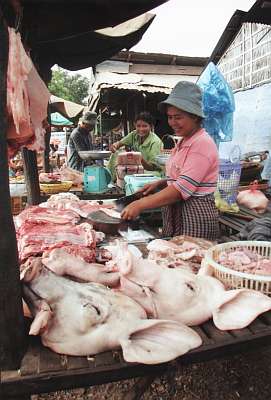
18 August 2006
She's just barely hanging on but at least the jackfruit is strapped down. 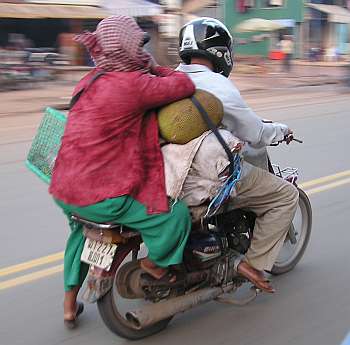
Motorcycle Passengers and Cargo #32
13 August 2006

If OSHA (Occupational Safety and Health Administration) from the United States were operating in Cambodia, they would just close the country. There is almost no safety—and relatively little safety awareness—in the kingdom. This is a picture of the dirt street next to our deaf office. This end of the street has been completely taken over by five or six squatter huts so that there is no through access on the street anymore. Last week, one of the "homeowners" decided to put an addition on his home. The pitch of the new roof was so steep that the man with the hammer couldn't put in the nails so his friend made a "safety harness" to keep him from sliding down the roof. Everyone was still alive at the end of the day.
11 August 2006
The electrical wiring for our house on Street 334 comes from the pole on the street and is not taken through a junction box for distribution through the house but is just tied off on some concrete louvers that are part of the house architecture. Notice there are no automatic circuit breakers, just manual switches to turn the power supply on and off for the whole house.
From the entry point to the property (above) the wires come downstairs from the big switches to some smaller switches (which control outside lights) and to individual wires running throughout the house. There are probably some kind of electrical codes put into regulations somewhere along the line but they are certainly not enforced. Every homeowner just does his own wiring as cheaply as he can. 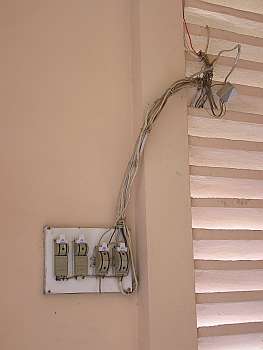
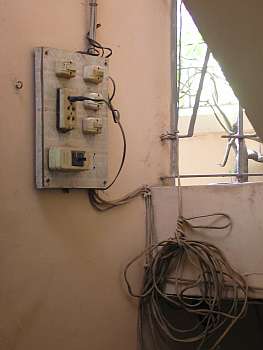
10 August 2006
Six people on a motorcycle! And notice mom is carrying a cooler and there's a big white bag of something under the driver. 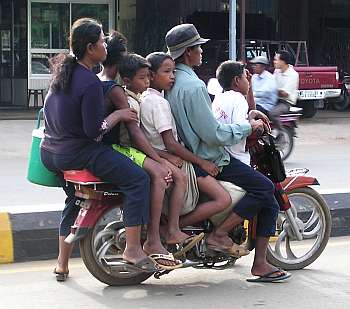
Motorcycle Passengers and Cargo #31
4 August 2006
Lanes? What's a lane? 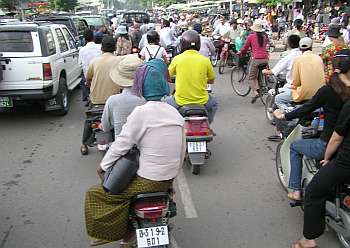
2 August 2006
Phnom Penh is full of trucks making all kinds of deliveries around town. Usually each truck has two or three young men as "helpers," those who do the dirty work. Here a truck takes a load of something to a destination in the city, with a helper enjoying the breeze from his perch in front. If they travel on any of the small side streets, it is the helper's responsibility to lift the low-hanging telephone and electrical wires so they don't get caught on the truck's load. Photo by Jim McLaughlin 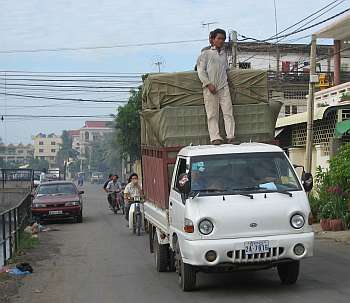
24 July 2006
You've heard of FTD? This is it, Cambodia-style. (No, not really. This man is delivering wholesale flowers to a market.) 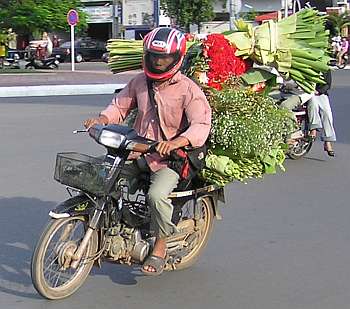
Motorcycle Passengers and Cargo #29
19 May 2006
You can take your clothes to the laundry, or you can take a washing machine home with you.... 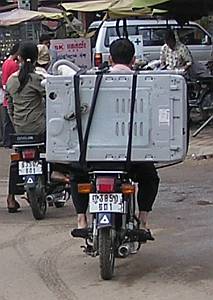
Motorcycle Passengers and Cargo #28
9 May 2006
Many neighborhoods have small markets along one of the local streets. This is a picture of one near our deaf office. Click here for more photos. 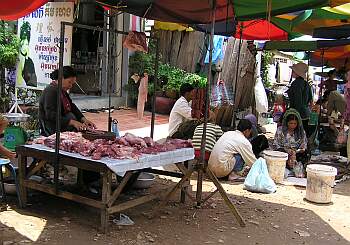
5 May 2006
Just barely hanging on! 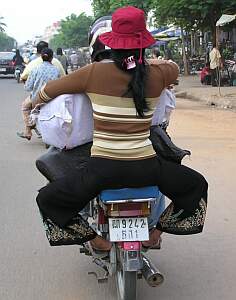
Motorcycle Passengers and Cargo #27
29 April 2006
"Hey, his load is higher than mine!" 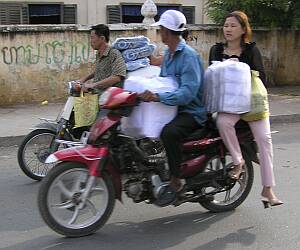
Motorcycle Passengers and Cargo #26
27 April 2006
Do you think he gets good reception? 
26 April 2006
 When you hear the phrase "motorcycle gloves," you probably think of thick leather gloves. But here in Cambodia, the gloves worn most often by motorcyclists are those worn by women. These shoulder-length gloves protect their arms from the sun to keep their skin from getting dark. Unfortunately, even here lighter skin is better than darker, and European white is the color to be!
When you hear the phrase "motorcycle gloves," you probably think of thick leather gloves. But here in Cambodia, the gloves worn most often by motorcyclists are those worn by women. These shoulder-length gloves protect their arms from the sun to keep their skin from getting dark. Unfortunately, even here lighter skin is better than darker, and European white is the color to be!
7 April 2006
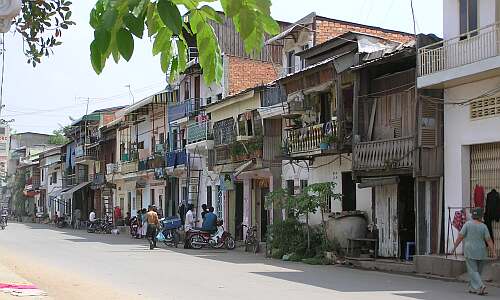
This is a typical street scene--probably lower middle-class--in Phnom Penh.
5 April 2006
Baby on board 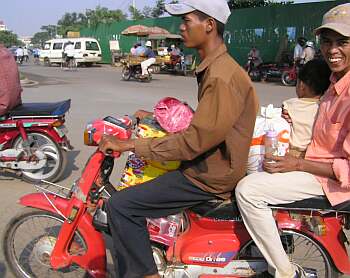
Motorcycle Passengers and Cargo #25
31 March 2006
 A few days I noticed that a new building (left) at a local high school actually has windows with glass in them. This is the first Ministry of Education school with real glass windows that I have seen in Cambodia. Normally the schools have shutters with louvers that cover window openings with bars in them as in the building on the right. Schools run by NGOs might have glass windows, but this is a first in a government school in my experience.
A few days I noticed that a new building (left) at a local high school actually has windows with glass in them. This is the first Ministry of Education school with real glass windows that I have seen in Cambodia. Normally the schools have shutters with louvers that cover window openings with bars in them as in the building on the right. Schools run by NGOs might have glass windows, but this is a first in a government school in my experience.
30 March 2006
Repairing something here is much easier than in the US. We just called the name of the dealer on a sticker on top, he sent over worker on a motorcycle, and he determined that we had burned out something with the 220 v. He ended up making three trips, repairing the washer and then installing the black box on the wall on the right which is a stepdown transformer from 220v to 110v. The whole repair job cost us $28! The paper on the wall above the washer is a printout of a photo of the controls for the washer. The labels are all written in Japanese so we had a neighbor write the English equivalents for us.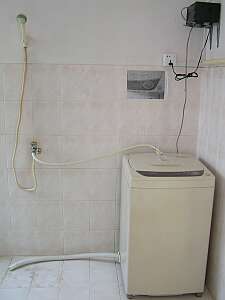 This is a photo of the Japanese washing machine we installed at our new house on Street 334 in Phnom Penh. I have had the washer at the deaf office for a couple years. We had acquired it for two of our advisors when they were living here for several years, but after they left, I just stored it. When we moved to our new house, we needed a washer so I cleaned this one up and plugged it in. It didn't work because it is a 110 volt washer (Japan has some 110 volts and some 220 volts) and the Cambodian electricity (when we have it) is 220 volts.
This is a photo of the Japanese washing machine we installed at our new house on Street 334 in Phnom Penh. I have had the washer at the deaf office for a couple years. We had acquired it for two of our advisors when they were living here for several years, but after they left, I just stored it. When we moved to our new house, we needed a washer so I cleaned this one up and plugged it in. It didn't work because it is a 110 volt washer (Japan has some 110 volts and some 220 volts) and the Cambodian electricity (when we have it) is 220 volts.
28 March 2006
Motorcycle Passengers and Cargo #24 A motorcycle with a rear platform: the Cambodian version of a pickup truck. 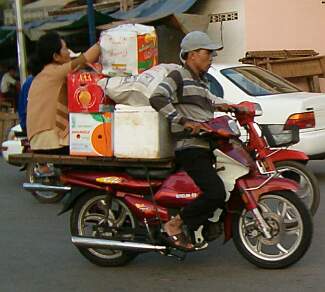
27 March 2006
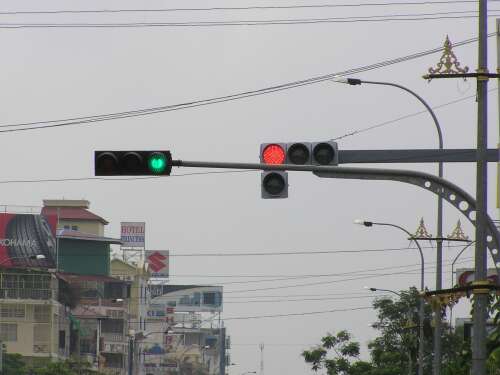
What is unusual about this picture? First, the fact that the stoplights are working! There aren't that many stoplights in Phnom Penh (no other Cambodian cities have any) and it is quite common for any red or green light--or the whole fixture--to be not working, even for weeks at a time. A second odd feature is having both a red and green and light on at the same time, facing the same direction. That's not a problem here, though, because stoplights are optional so whether it is red or green is rather inconsequential.
25 March 2006
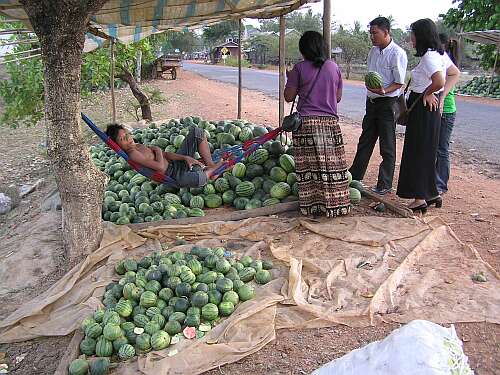
On the way back from Kampot province, our staff wanted to stop to buy some watermelons at a roadside stand. Watermelons are very small in Cambodia. The smallest ones, about the size of a softball, are 300 riel (7.5¢).
23 March 2006
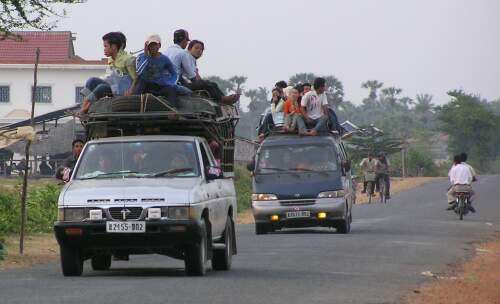
Various forms of transportation in rural Kampot province
17 March 2006
Motorcycle Passengers and Cargo #23 I don't know what they are but there's too many of them for one motorcycle. 
11 March 2006
Many, many places in Cambodia, electrical wires are strung up on unwieldy bamboo poles, but in some places there are actual utility poles erected to carry the wires. There is no standard for erecting wiring, though, and anyone who wants can put anything on the pole. This pole shows various styles of connections. [1] An official mounting, solidly secured with a bolt through the pole. [2] A metal strip securing an anchor on the backside of the pole. [3] Just running a wire through one of the holes in the pole, without using any kind of anchor. [4] Running a wire through one of the holes, like in [3], and then tying it in a loop. Using a pole is first-come, first-served. This one is relatively unencumbered with its load of electrical, telephone, and cable TV wires. 
6 March 2006
Motorcycle Passengers and Cargo #22 "Oh, I thought I'd just run over to the store and pick up a few vegetables for supper...." 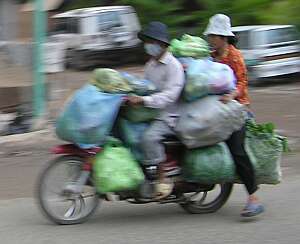
28 February 2006
At the previous house I lived in, the houseowner had run the electrical wires from the poles on the street through a chainlink fence to the house. No need for a pole or any running the wires overhead. It was cheaper and easier just to weave them in and out of the chainlinks of the fence. That was the house where the power went out every time it rained. This is a picture of the street where our deaf office is. A garbage truck wending its way through the rough streets has to keep one of the crew on the top of the truck to lift the wires so the truck can go underneath. Of course, there's no protection or security measures. The guy on top just uses his bare hands.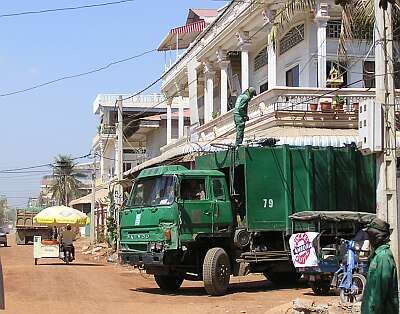 A fact of life on Phnom Penh streets are the telephone and power lines dangling low, even touching the roadway. Probably a good percentage of the lines on the power poles in the city don't work. No old line is ever taken down. New ones are just added constantly, some of them by the power companies, some of them by householders stealing electricity. There are no standards to follow so anyone puts up a utility pole or strings wires and cables anyway he wants. When wires break or fall from the poles into the street, they just stay there until a passing car jerks them down or neighborhood kids pull them down to sell them for scrap.
A fact of life on Phnom Penh streets are the telephone and power lines dangling low, even touching the roadway. Probably a good percentage of the lines on the power poles in the city don't work. No old line is ever taken down. New ones are just added constantly, some of them by the power companies, some of them by householders stealing electricity. There are no standards to follow so anyone puts up a utility pole or strings wires and cables anyway he wants. When wires break or fall from the poles into the street, they just stay there until a passing car jerks them down or neighborhood kids pull them down to sell them for scrap.
18 February 2006
A van waiting for the last 10 or 15 passengers before heading off to a destination in the provinces. A guy can't make any money running half empty!! 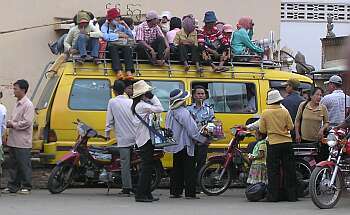
10 February 2006
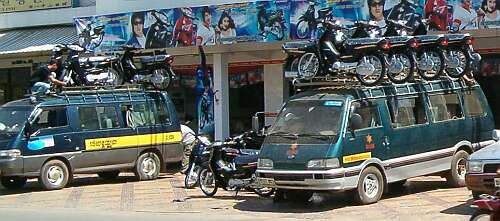
Vans plying the routes to and from the provinces carry anything and everything that will fit in or on top of the vehicles. These motorcycles are being loaded on top of vans at a Honda dealership in Phnom Penh.
8 February 2006
Motorcycle Passengers and Cargo #21 A helmet would definitely be in order in case of any quick stops... 
2 February 2006
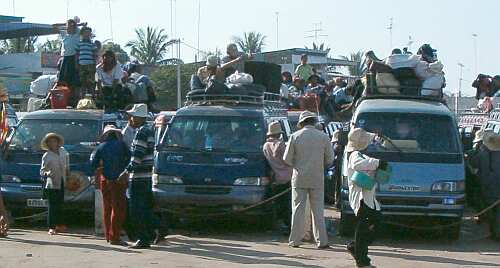
Three vans waiting to be first on to the ferry cross the Mekong River at Neak Louen. Traveling in such a van, whether inside or on top, is not for the faint-hearted.
1 February 2006
Motorcycle Passengers and Cargo #20 In the US, when I worked in the trucking industry, there was a motto: "If you have it, it came by truck." Just about anything and everything travels at some point by motorbike here. 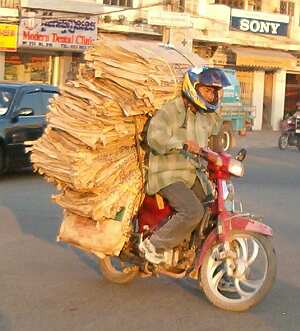
Cruelty to Animals (Part 2)
The chickens don't squeal the way the pigs do, but their plight may not be any better. The normal mode of transporting chickens and ducks here is to tie their feet together and then lash them upside down onto motorbike handlebars or on to the side of a truck as in this photo, also taken at the Neak Louen ferry across the Mekong River. 
Cruelty to Animals (Part 1)
There is little sense of the rights of animals in Cambodia, little attention paid to their suffering under sometimes really inhumane conditions. Maybe the suffering of so many of the people dulls them to the pain of the animals which are so much a part of their lives and livelihoods. This is a picture of a pickup truck full of pigs, loaded into bamboo wicker baskets, on their way to market. These animals were photographed at Neak Louen, the ferry across the Mekong River on Highway 1 (of Vietnam War fame). The picture below is an enlargement of a section of the above photo, showing the pigs crammed into the circular wicker baskets. Some of the pigs were bleeding from bites of other terrified pigs and from the jolting over the rough roads. On top of and between the two baskets is the carcass of a pig that didn't survive the first part of the journey. 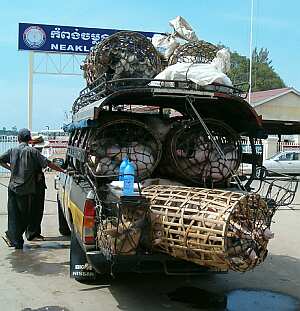
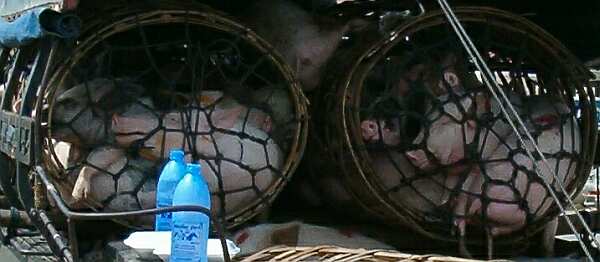
25 January 2006
Motorcycle Passengers and Cargo #19 A Cambodian convertible (It was cloudy and looked like rain so they put the top up.) 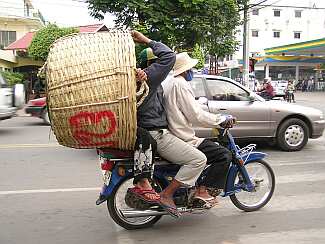
21 January 2006
But now in addition we are experiencing a power cut in the evening almost every other day. Here in the tropics, there is almost no dusk. It goes from light to dark quickly, and when the power goes off at 6:00 or 6:30 PM, we are stuck. What can you do in the dark for one to three hours in the early evening? What is frustrating is that the lights don't go out for the government officials and the people in the rich neighborhoods. It's basically the poor and powerless who sweat in the dark. During the longest outages, I go into my bathroom with its white tile walls and use a small kerosene lamp and a wind-up flashlight to read, but it sure gets hot in there. On Monday we are taking a UPS that we use on a computer and having it connected to a car battery. That way when the power goes out, the UPS will not just give five or ten minutes to shut down a computer, but will allow us to continue working for two to three hours, albeit without the ever-present ceiling fans. The power situation in Phnom Penh is getting worse and worse. We should be at our most energy efficient time of the year now, at the end of the rainy season when the reservoirs for generating electricity are full, but instead we are experiencing more and more power cuts. This is an image of our neighborhood at 6:30 in the evening. For the past year, three or four days a week we have been having power cuts in the morning. Each would last from one to three hours.
The power situation in Phnom Penh is getting worse and worse. We should be at our most energy efficient time of the year now, at the end of the rainy season when the reservoirs for generating electricity are full, but instead we are experiencing more and more power cuts. This is an image of our neighborhood at 6:30 in the evening. For the past year, three or four days a week we have been having power cuts in the morning. Each would last from one to three hours.
20 January 2006
Motorcycle Passengers and Cargo #18 You just need to be a little careful in making turns.... 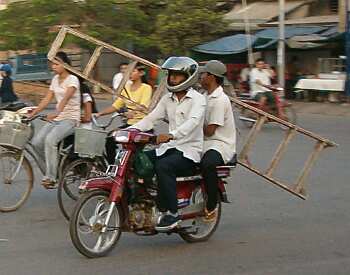
8 January 2006
Motorcycle Passengers and Cargo #17 Carpooling to school in the morning takes on a different meaning in Cambodia! 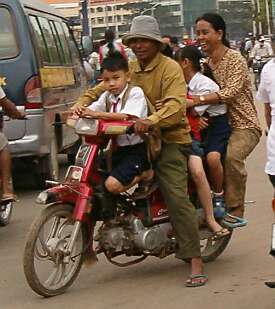
2 January 2006
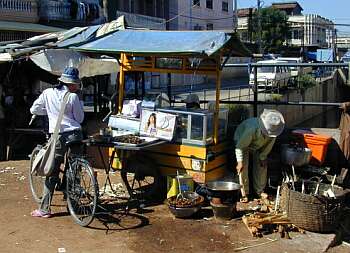 The previous photo of two women buying deep-fried bananas from their motorbike prompted Jim McLaughlin to send me his photo of another young woman buying fast food from her bicycle. Only this time the food is large insects, also deep-fried in the wok on the little burner on the ground. Jim wasn't sure if they were cockroaches or grasshoppers. Notice the mobile food stall is located right above a large open sewer that runs through our section of town. Any open space like that on public property is prime real estate for the vendors. Remember, it's all about location, location, location!
The previous photo of two women buying deep-fried bananas from their motorbike prompted Jim McLaughlin to send me his photo of another young woman buying fast food from her bicycle. Only this time the food is large insects, also deep-fried in the wok on the little burner on the ground. Jim wasn't sure if they were cockroaches or grasshoppers. Notice the mobile food stall is located right above a large open sewer that runs through our section of town. Any open space like that on public property is prime real estate for the vendors. Remember, it's all about location, location, location!
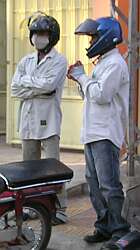
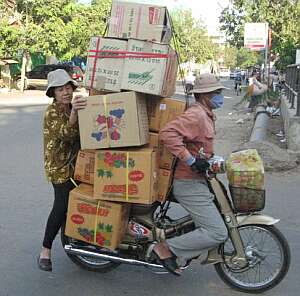
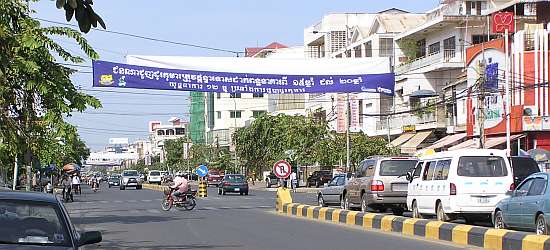
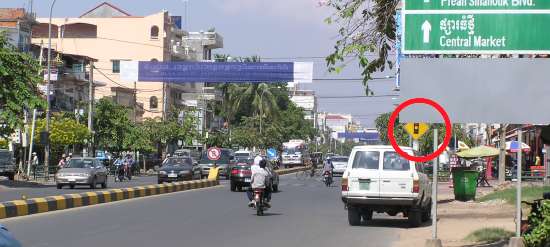
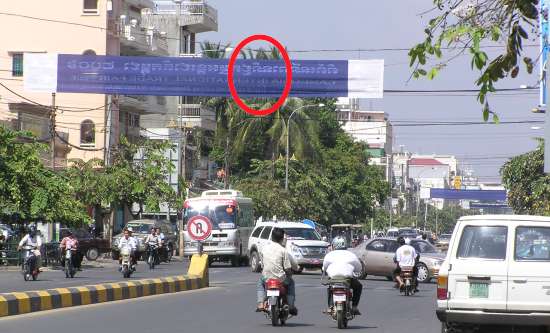
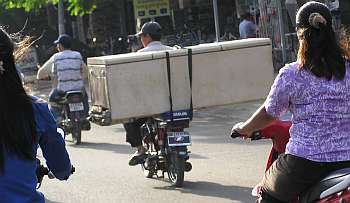

 Hot and cold are somewhat relative terms. Recently I found the fans removed from the classrooms at DDP. When I asked why, I was told that they were not needed now because it is winter. When I went home a few minutes later, it was 86ºF/30ºC on my thermometer on my desk.
Hot and cold are somewhat relative terms. Recently I found the fans removed from the classrooms at DDP. When I asked why, I was told that they were not needed now because it is winter. When I went home a few minutes later, it was 86ºF/30ºC on my thermometer on my desk. 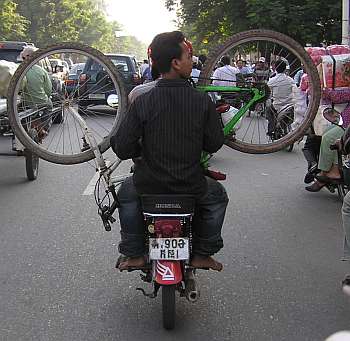
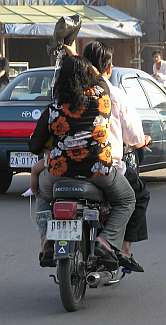
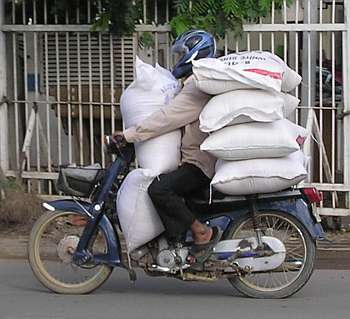
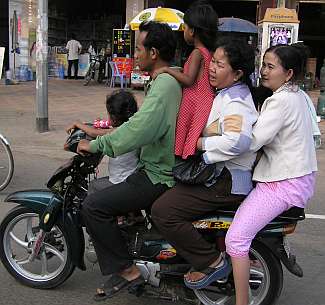

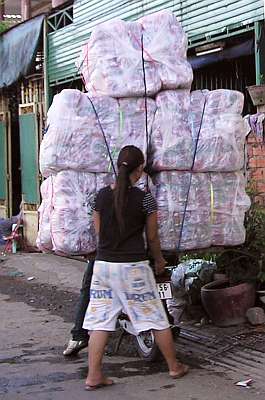
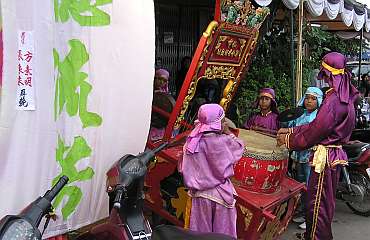
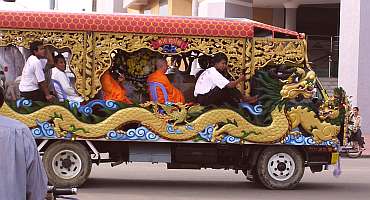 Chinese people are a relatively small percentage of the population of Cambodia, but their influence is disproportionate to their numbers. As in most other Asian countries, it is the Chinese citizens who often run the local appliance shops, electronics stores, etc. They are known for their business sense and their relative wealth, and their economic status is reflected even in things like funerals. Many Chinese people are buried rather than cremated like the Khmer people. And here a local Chinese person's body is carried to its resting place in an elaborately decorated funeral truck which a Khmer person would never consider, both because of the difference in burial customs and the cost of such a rental.
Chinese people are a relatively small percentage of the population of Cambodia, but their influence is disproportionate to their numbers. As in most other Asian countries, it is the Chinese citizens who often run the local appliance shops, electronics stores, etc. They are known for their business sense and their relative wealth, and their economic status is reflected even in things like funerals. Many Chinese people are buried rather than cremated like the Khmer people. And here a local Chinese person's body is carried to its resting place in an elaborately decorated funeral truck which a Khmer person would never consider, both because of the difference in burial customs and the cost of such a rental.